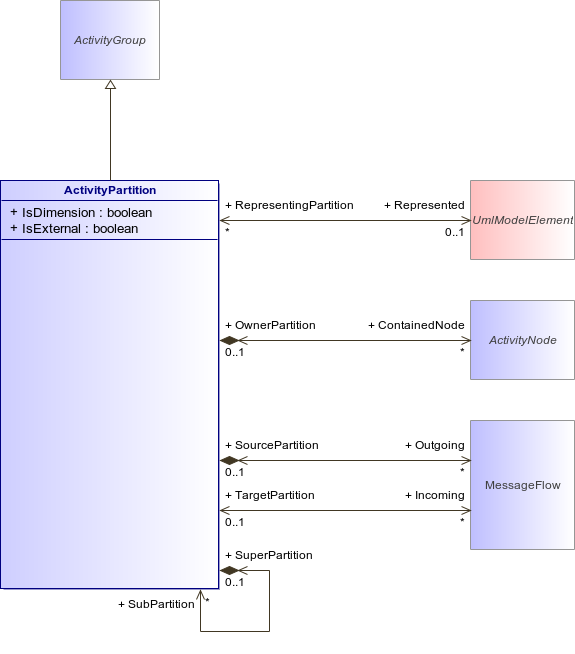
UML/BPMN Metamodel
Kind of activity group for identifying actions that have some characteristic in common.
Partitions divide the nodes and edges to constrain and show a view of the contained nodes. Partitions can share contents. They often correspond to organizational units in a business model. They may be used to allocate characteristics or resources among the nodes of an activity.
Partitions do not affect the token flow of the model. They constrain and provide a view on the behaviors invoked in activities. Constraints vary according to the type of element that the partition represents. The following constraints are normative:
1) Classifier
Behaviors of invocations contained by the partition are the responsibility of instances of the classifier represented by the partition. This means the context of invoked behaviors is the classifier. Invoked procedures containing a call to an operation or sending a signal must target objects at runtime that are instances of the classifier.
2) Instance
This imposes the same constraints as classifier, but restricted to a particular instance of the classifier.
3) Part
Behaviors of invocations contained by the partition are the responsibility of instances playing the part represented by the partition. This imposes the constraints for classifiers above according to the type of the part. In addition, invoked procedures containing a call to an operation or sending a signal must target objects at runtime that play the part at the time the message is sent. Just as partitions in the same dimension and nesting must be represented by parts of the same classifier's internal structure, all the runtime target objects of operation and signal passing invoked by the same execution of the activity must play parts of the same instance of the structured classifier. In particular, if an activity is executed in the context of a particular object at runtime, the parts of that object will be used as targets. If a part has more than one object playing it at runtime, the invocations are treated as if they were multiple, that is, the calls are sent in parallel, and the invocation does not complete until all the operations return.
4) Attribute and Value
A partition may be represented by an attribute and its subpartitions by values of that attribute. Behaviors of invocations contained by the subpartition have this attribute and the value represented by the subpartition. For example, a partition may represent the location at which a behavior is carried out, and the subpartitions would represent specific values for that attribute, such as Chicago. The location attribute could be on the process class associated with an activity, or added in a profile to extend behaviors with these attributes.

Figure 102 : ActivityPartition (architecture_autodiagram)
Attribute | Description |
|---|---|
boolean IsDimension [1..1] | Indicates whether the partition groups other partitions along a dimension. |
boolean IsExternal [1..1] | Indicates whether the partition represents an entity to which the partitioning structure does not apply. |
Association | Description |
|---|---|
An element constraining behaviors invoked by nodes in the partition. A partition should represent a classifier, an attribute, its value a parameter or an instance. | |
Nodes immediately contained in the partition. | |
Outgoing BPMN messages. | |
Partitions immediately contained in the partition. | |